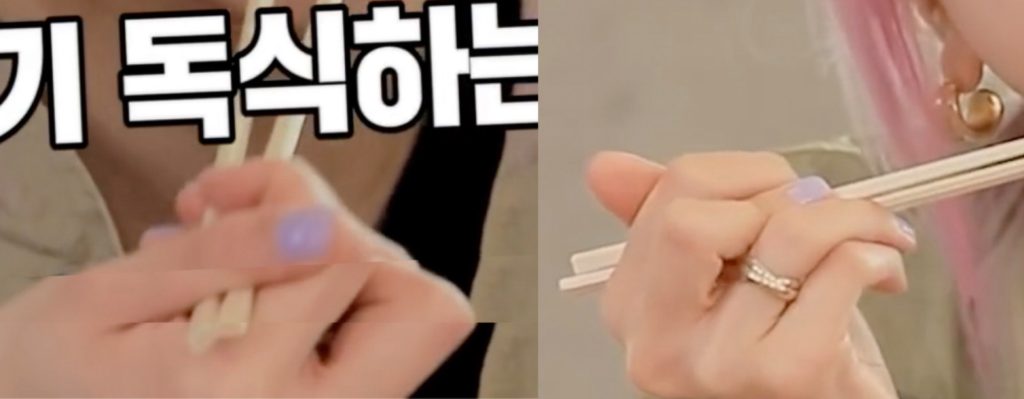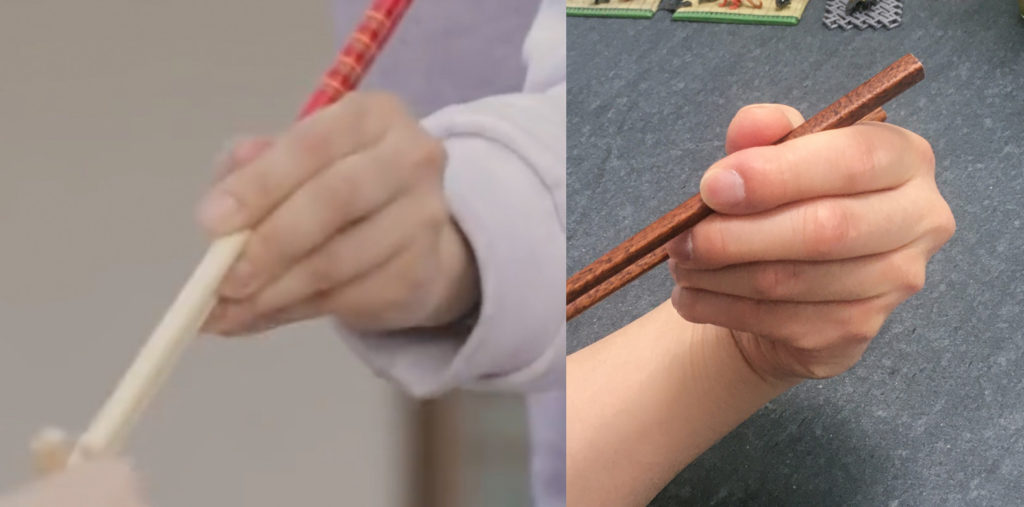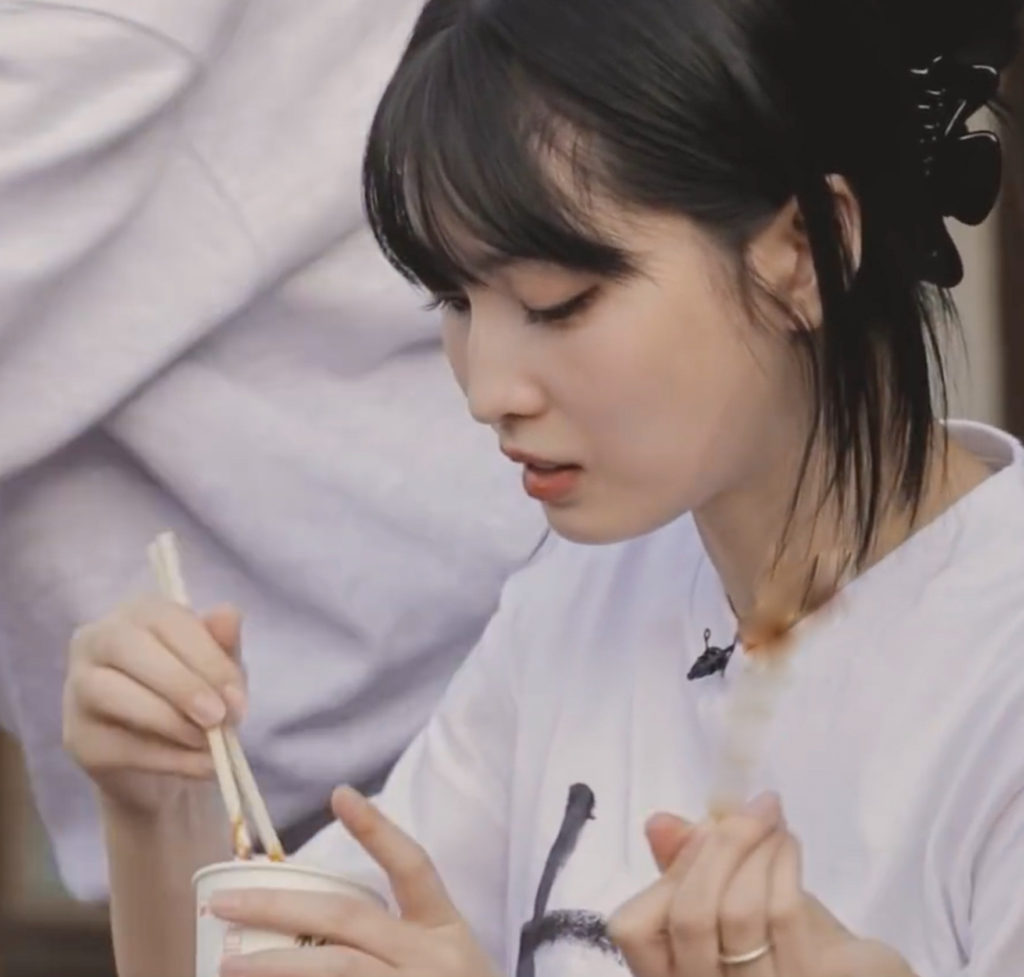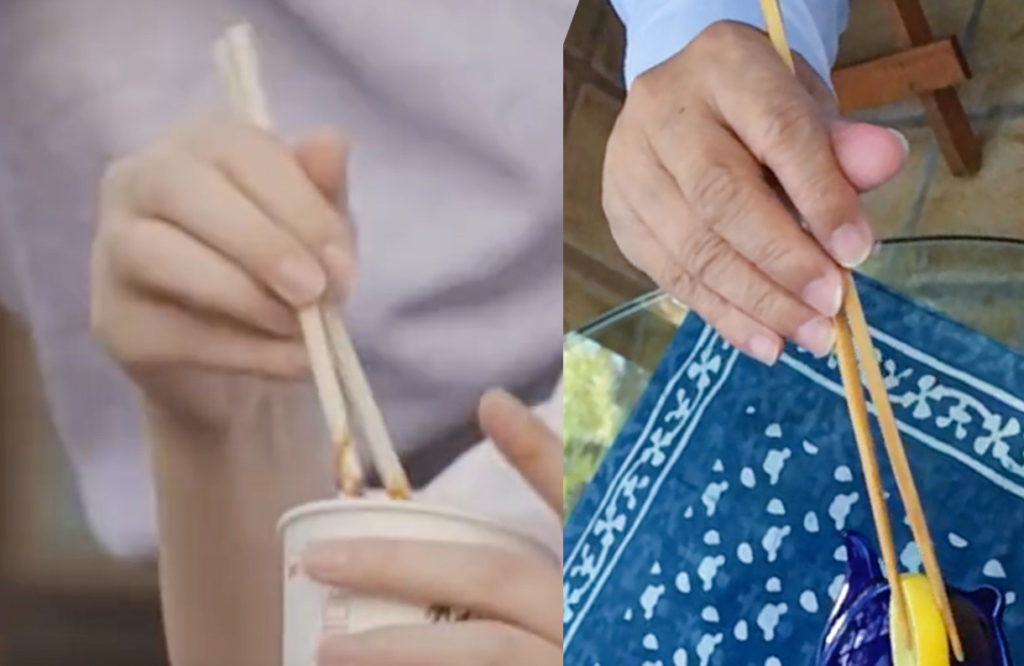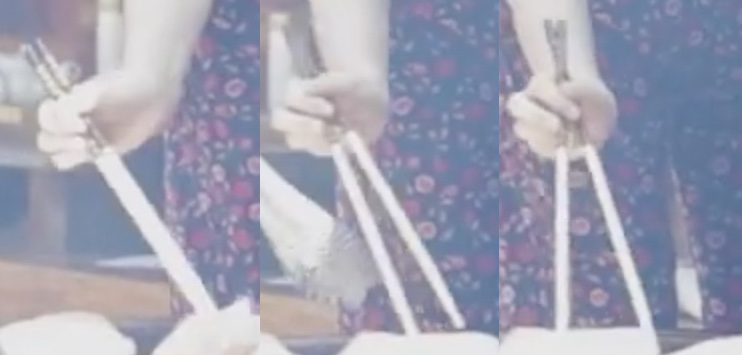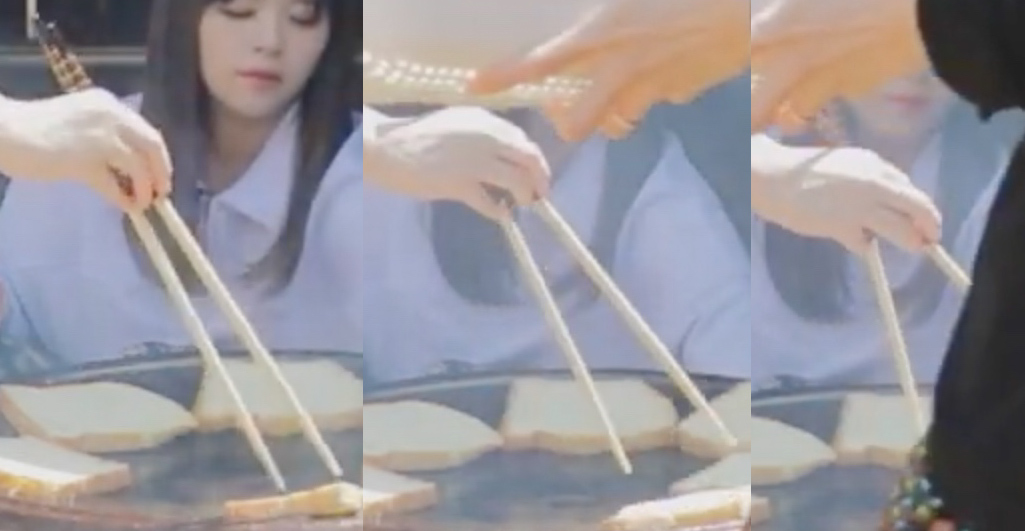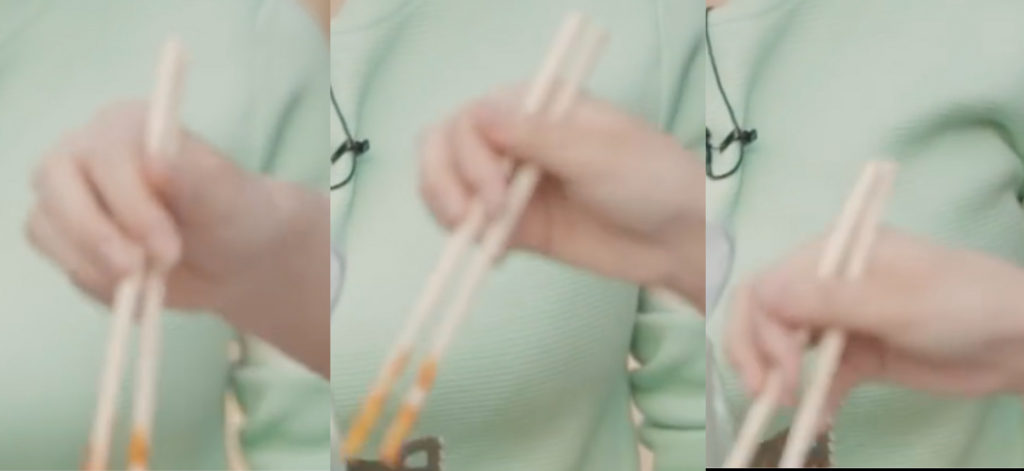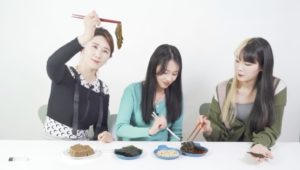Last Updated on 2021 年 08 月 29 日 by 編輯
What chopstick grips do TWICE members use?
Read on to find out what chopstick grips each of the 9 members of TWICE mastered. The following one-minute video gives you quick summary of the result of analysis from this article.
內容目錄
Our contestants
All 9 members of TWICE are shown below. They are Chaeyoung, Dahyun, Jeongyeon, Jihyo, Mina, Momo, Nayeon, Sana, and Tzuyu.
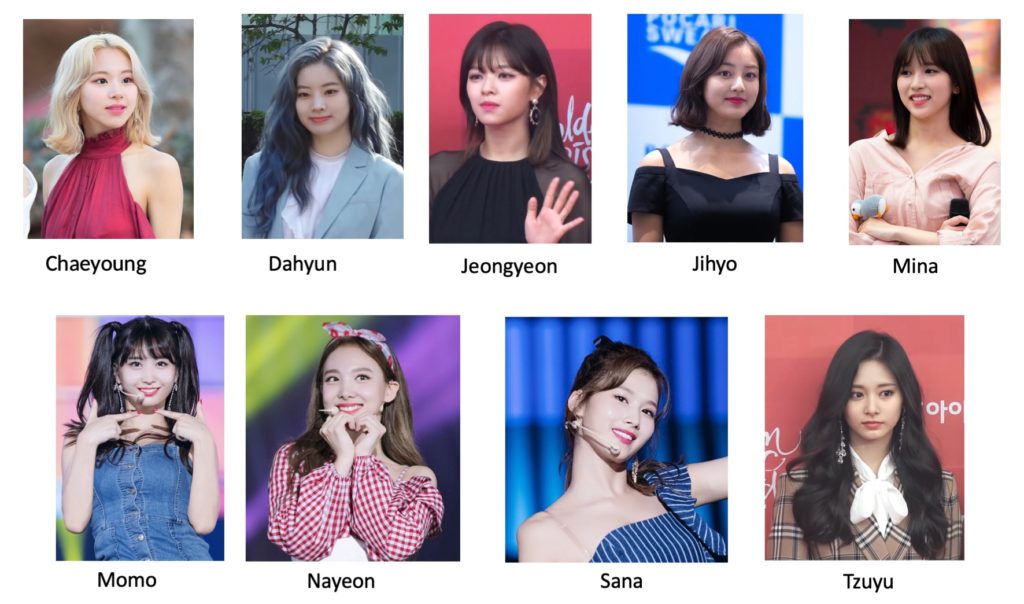
Some members have mastered two or more chopstick grips, and thus belong to more than one chopstick teams. Which team includes the most TWICE members? Perhaps you have watched enough TWICE videos that you know the answer already. Take a guess before you continue on.
Pictures in this article are taken from various episodes of “TIME TO TWICE” such as Yes-or-No episode 2, episode 3, TDOONG Forest episode 2, episode 3 and episode 6.
Chaeyoung: Hook n Clamp
By watching the above-mentioned videos, we were able to map every TWICE member’s chopstick grip, except for Chaeyoung. Her grip is one we had not previously captured in our growing collection of chopsticking footages. Not only did we add her new Hook n Clamp grip to our grip classification table, but we also identified a previously written but not named grip from our WorldFriend article. We now knew how to name Jane’s grip – we call it Double Hook, as a variant of Chaeyoung’s Hook n Clamp.
The Hook n Clamp chopstick grip uses the index finger to pry chopsticks open, and the middle finger to clamp chopsticks shut. Following is a typical view of this grip, as demonstrated by Chaeyoung.

Key postures of this grip are shown below. From left to right, they are: 1) Open posture, 2) Closed posture, 3) Compression posture, and 4) Abutting posture.

This grip is named after the way the index finger and the middle finger move the top chopstick. The index finger curls and hooks onto the top chopstick, shown below left. This allows the index finger to lift up the top chopstick, extending chopstick tips apart. When it comes time to pinch food, the middle finger clamps down on the top chopstick, pinning it against the bottom chopstick, shown below right.


Dahyun: Idling Thumb and its variants
Dahyun primarily wields Idling Thumb. But she seamlessly transitions from it to closely-related grips such as Chicken Claws and Double Hook as needed. Often she will switch to Turncoat‘s compression posture when pinching food between chopstick tips, as practitioners of Standard Grip and Idling Thumb often do.
In Yes-No episodes, they gave Dahyun and many others long cooking chopsticks. These long chopsticks accentuated every person’s own chopstick grips. Following is a picture of Dahyun demonstrating Idling Thumb using these long chopsticks.

Following images shows Dahyun picking up food with Idling Thumb. Note how at the compression posture where she applies pressure on chopsticks to pinch food, the rear ends of chopsticks are separate apart. This is one key factor differentiating Idling Thumb for its many closely-related grips such as Chicken Claws, Hook n Clamp, and Double Hook where rear ends abut at compression posture, and in fact serve as a pivot for the hand to clutch two chopsticks shut. Also note how the thumb joint is used to secure the top chopstick, at the compression posture, and not the thumb base as in its closely-related grips.

Following images show Dahyun’s Idling Thumb Open Posture as observed from various different perspectives. Remember that Idling Thumb looks the same, in this open posture, as Double Hook and even Turncoat. All three of them share this same snapshot moment in their own, slightly different alternating motions of extending chopsticks apart and closing them again.
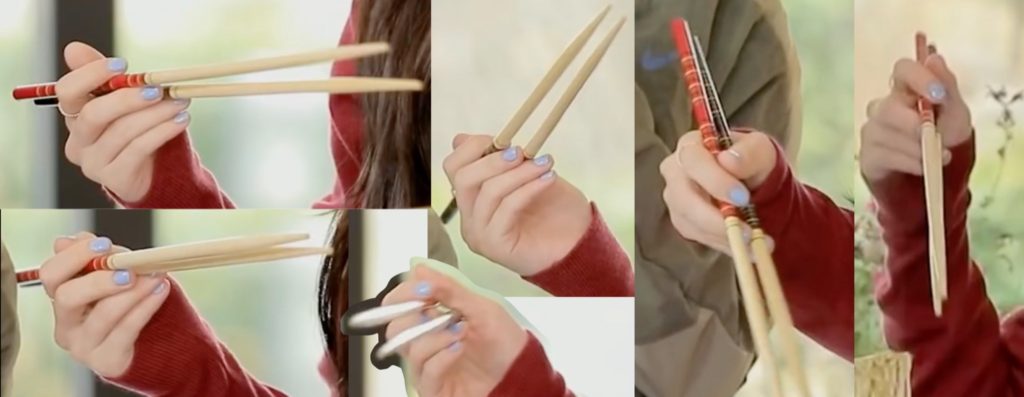
Following are images showing the closed posture without payload, and compression posture with payload. Again, note how the rear ends are separated at these postures, identifying the grip as Idling Thumb.

Dahyun switch from Idling Thumb to Chicken Claws, for pinching and picking up food, at times. This grip clutches the two chopsticks using all fingers, the side and the base of the thumb, plus the purlicue. It is essentially the same the compression technique of all Lateral grips. The telltale sign is again the rear end of chopsticks during compression. These abut each other, and serve as a pivot for the two chopsticks, as the index finger and the thumb base clutch them shot.
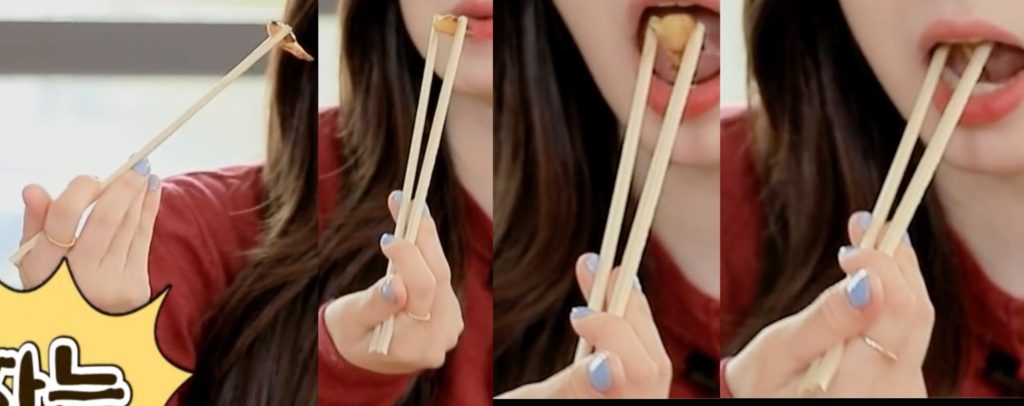
Like Jane from the WorldFriend article, Dahyun also wield Double Hook, a cross between Idling Thumb and Chicken Claws. In this grip, the knuckle of the middle finger is used to squash the top chopstick shut.
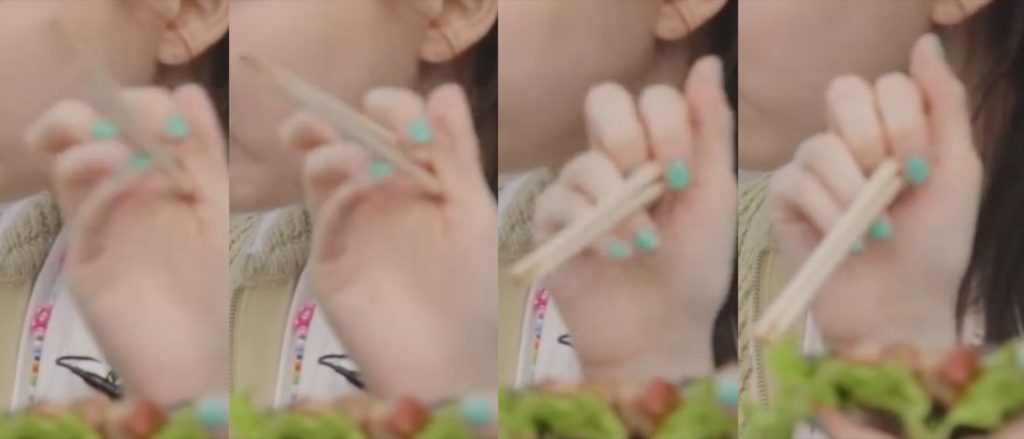
Many Standard Grip and Idling Thumb practitioners subconsciously shift the role of the middle finger from moving the top chopstick, to securing the bottom chopstick, when they compress these two chopsticks to pinch a food item. We call it the Turncoat grip, for the middle finger has switched allegiance away from the top chopstick. We discussed Kotoha switching from Standard Grip to Turncoat, in the WorldFriend article. And this topic is elaborated further in the Idling Thumb article. Here we see Dahyun doing the same, temporarily.

Jeongyeon: between Standard Grip and Idling Thumb
They also gave Jeongyeon long cooking chopsticks in the TDOONG Forest episode. She carried on unfazed as if she’d been using these all her life. Jeongyeon is lefthanded. You’ll see her holding chopsticks in her left hand in this article. Unlike elsewhere on marcosticks.org, we won’t flip her pictures to match our mostly-righthanded image collection. Doing so for well-known practitioners would be too disruptive.
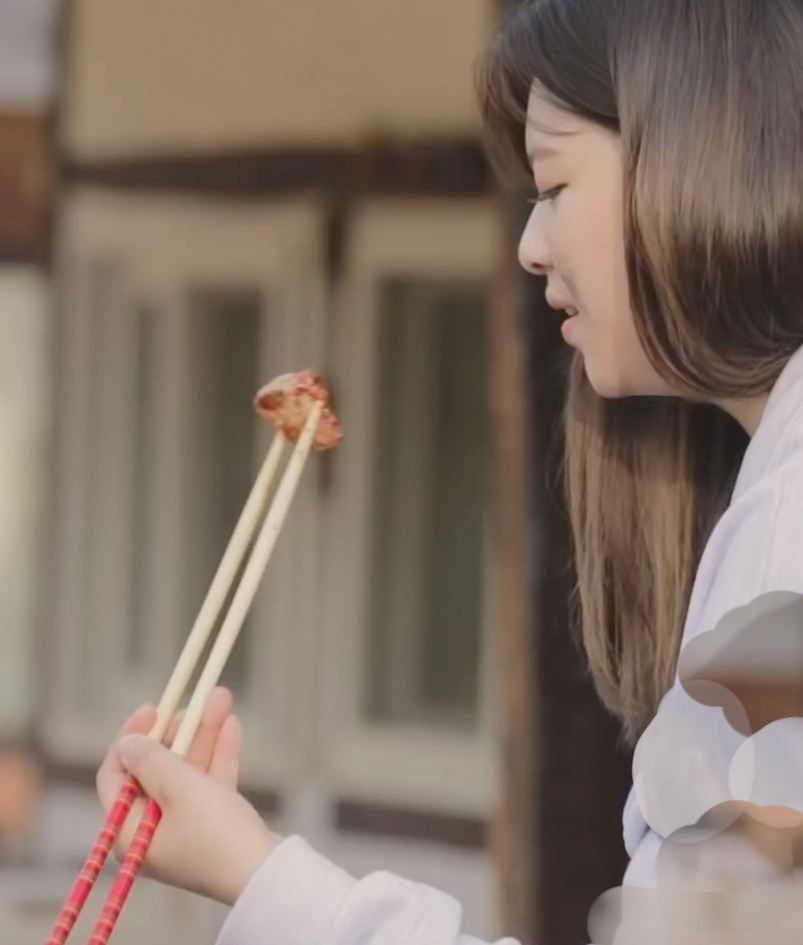
Jeongyeon wields a grip halfway between Standard Grip and Idling Thumb. So, most earlier discussions about Dahyun’s Idling Thumb and its close variants apply to Jeongyeon as well. Following are images showing various perspectives of her chopstick grip.

Following images show her approaching food with a relaxed open posture (left), closing chopsticks on food (middle), and then compressing chopsticks to securely pick up food (right). Her grip looks like Standard Grip, but deviates ever so slightly towards Idling Thumb.
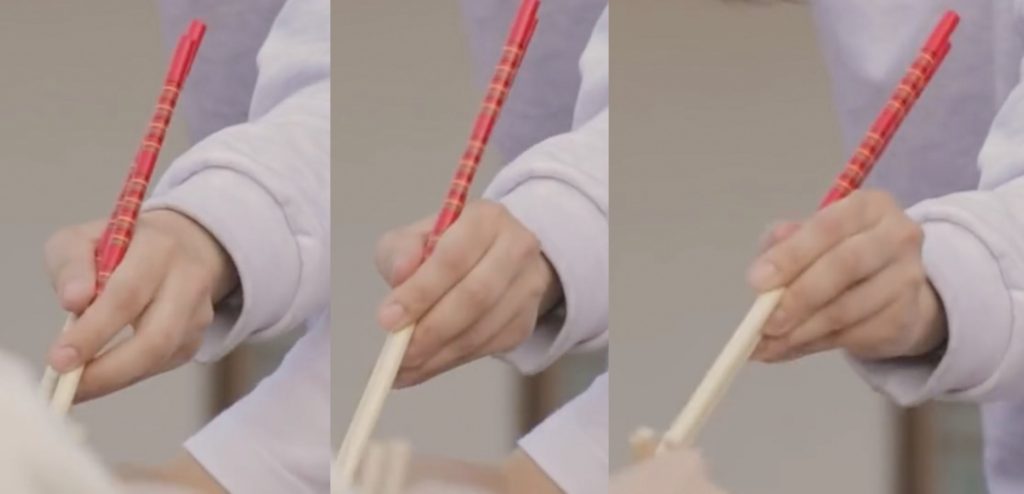
Jeongyeon employs her thumb pad more than Dahyun does. But like Dahyun, Jeongyeon has her index finger looped over to the side of the top chopstick. This subtly reduces the distances between the two chopsticks, and changes finger dynamics that operate on the top chopstick. It also causes the middle finger to be sandwiched between the two chopsticks at times.
Following depict the variant 2 of Idling Thumb, where the index finger curves around the thumb. But again, Jeongyeon’s grip is only halfway between Standard Grip and Idling Thumb. Her thumb pad remains more engaged in the movement of the top chopstick than regular Idling Thumb.
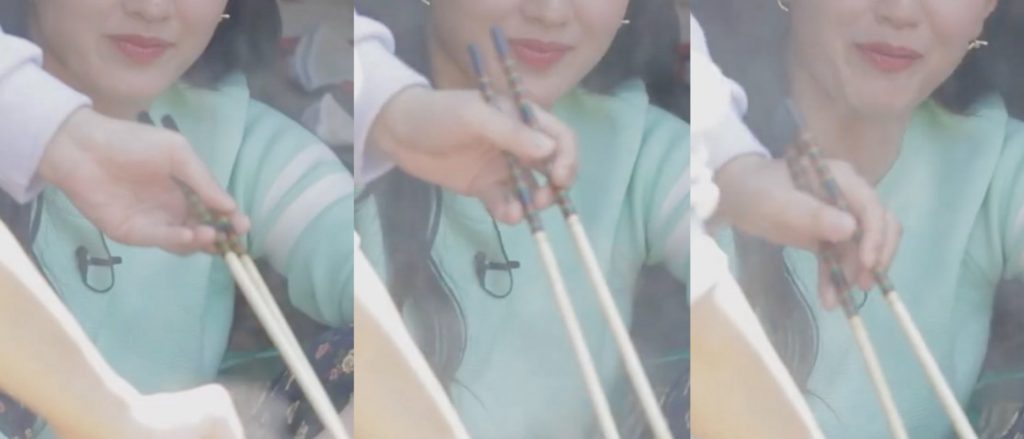
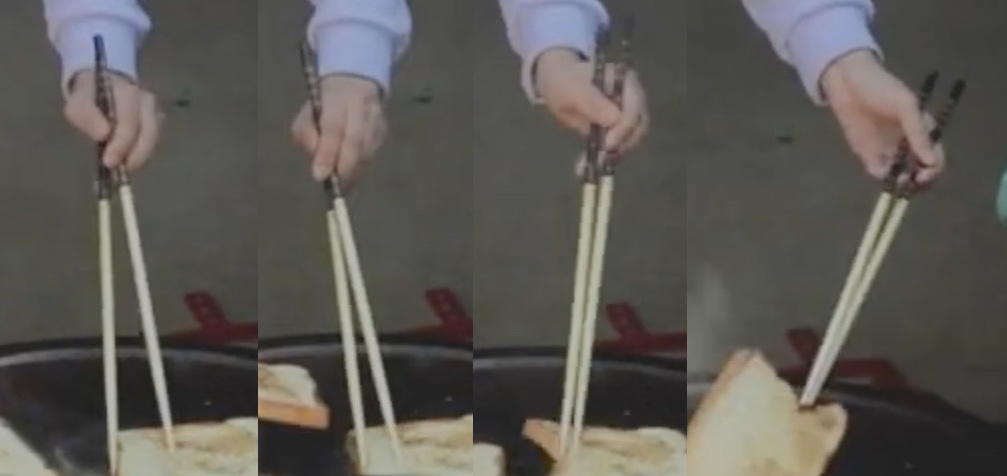
Just like Dahyun, Jeongyeon occasionally transitions into another closely-related grip, Double Hook. The index finger curls around the thumb completely (below center, and below right). The middle finger, too, curls inward, and presents its knuckle to squash the top chopstick downward against the bottom chopstick (below right). Rear ends of chopsticks now abut each other (below right).

Jihyo: Italian Grip
They gave Jihyo long cooking chopsticks in both the YesNo episode, and the TDOONG Forest episode. Jihyo is lefthanded, just like Jeongyeon.
Jihyo’s Italian Grip is named after the Italian hand gesture widely known as “Ma Che Vuoi”.
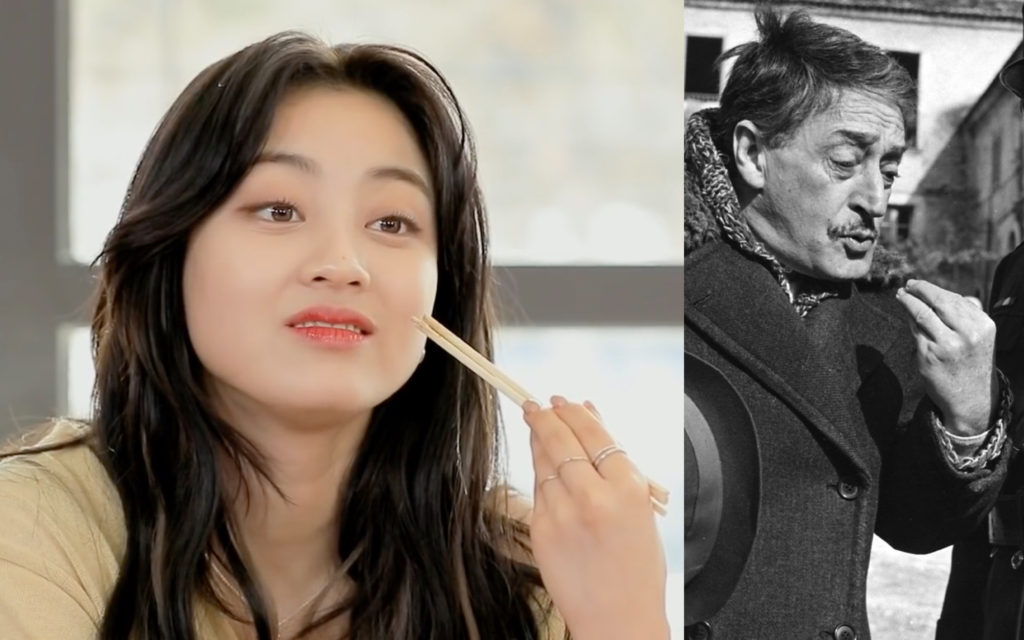
Italian Grip is a grip with an “underswing“, unlike chopstick grips discussed earlier. Standard Grip, Idling Thumb, Chicken Claws, Hook n Clamp, and Double Hook are all grips with a “classic” swing – they lift the top chopstick upward and away from the bottom chopstick. An underswing grip such as Italian Grip, Scissorhand, and Thumb Wrestler instead swings the top chopstick downwards under the bottom chopstick.
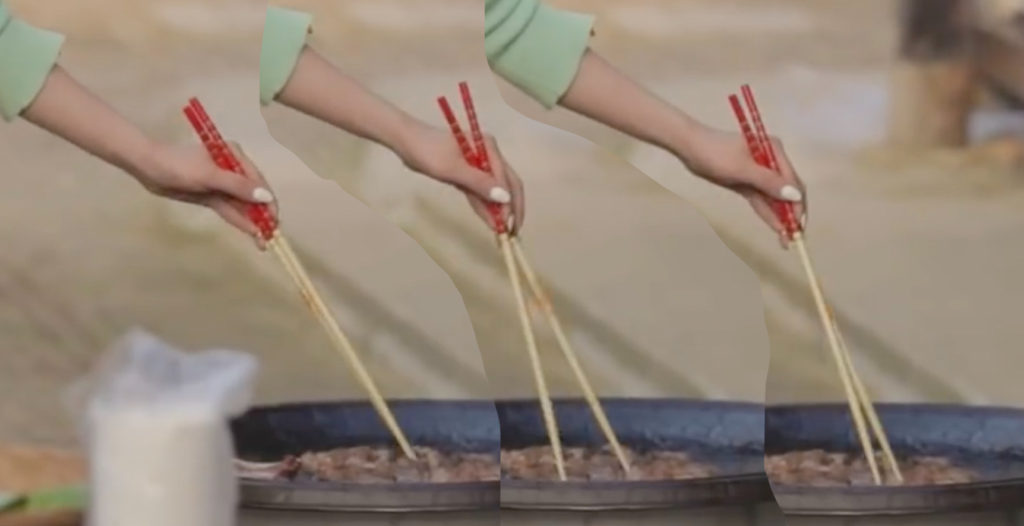
Italian Grip furls all five fingers around the two chopsticks, to clutch them shut against a food item, as shown below.
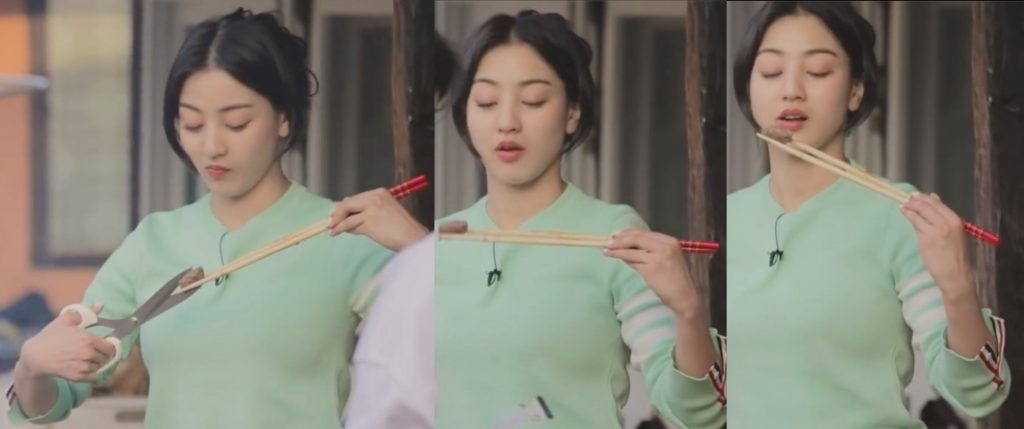
Following pictures illustrate the compression posture of Italian Grip, as seen from different perspectives.
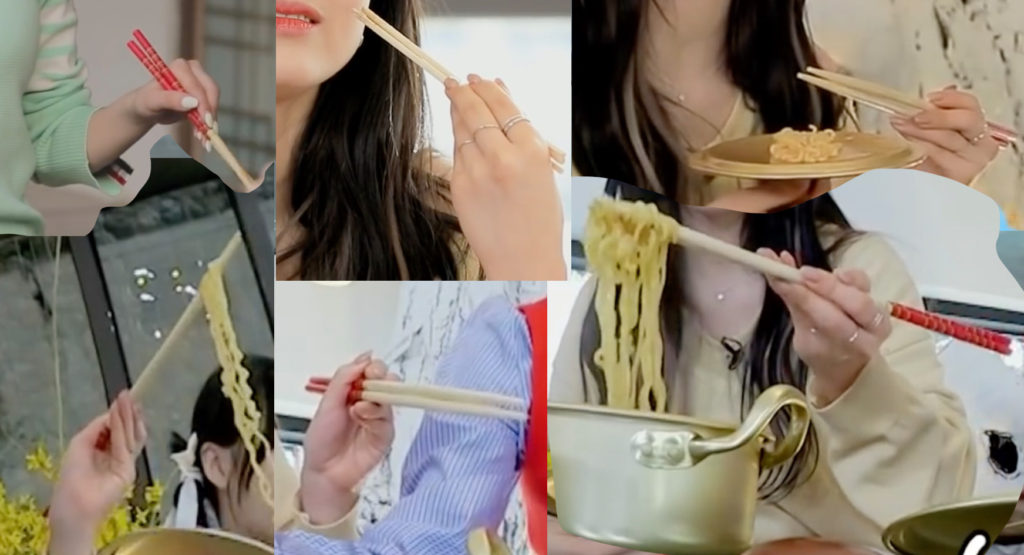
Pictures below illustrate the compression posture (below left), the relaxed closed posture (below center), and the open posture (below right).

Following images show typical hand and finger movements for picking up food, and for moving it to the mouth. A distinct feature of “cupped” grips such as Italian Grip and Cupped Vulcan is that, as the hand lifts off the food item, the back of the hand faces upward. This is the opposite of Lateral chopstick grips where the palm instead faces upward.
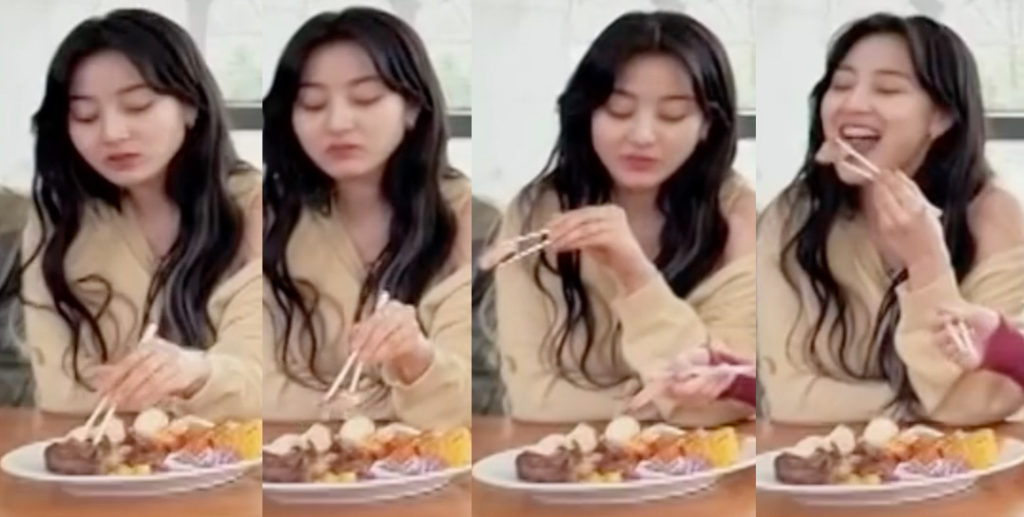
Mina: Turncoat
Mina wields exclusively the Turncoat grip, unlike Dahyun who dabbles in Turncoat outside of her usual Idling Thumb routines.
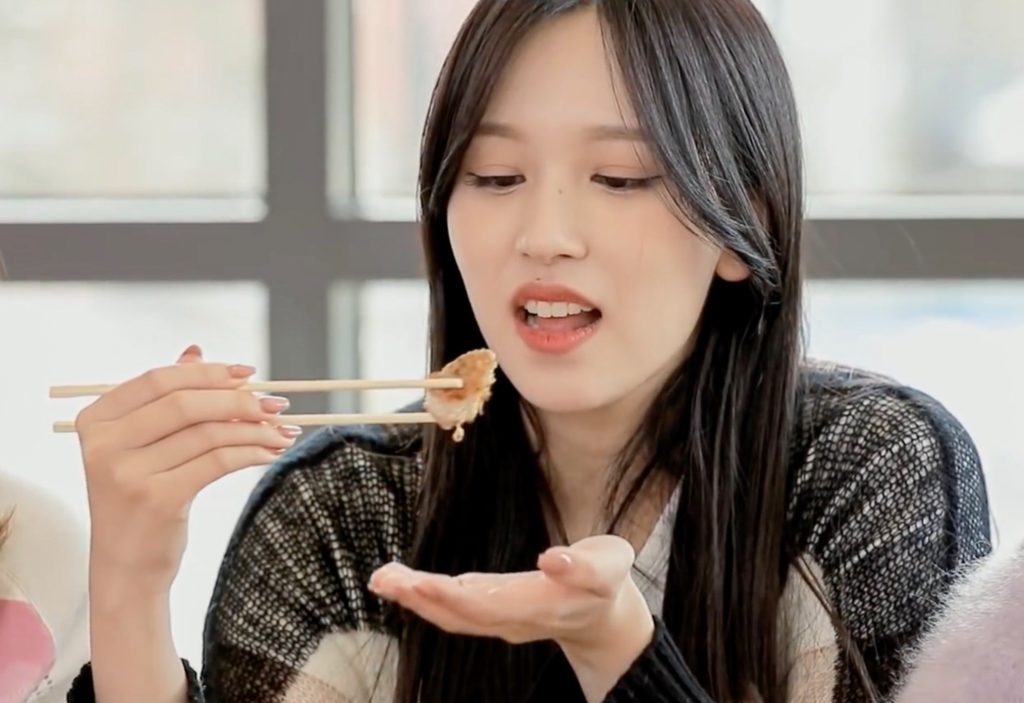
Following images show typical hand and finger movements for picking up food, and for moving it to the mouth.




Momo – Yet Unnamed grip
Earlier we wrote that we were able to map chopstick grips of all TWICE members, except for Chaeyoung. Well, we were wrong. Momo’s grip turned out to be a new grip as well.
When we sort through all screenshots of all members, we thought that Momo’s grip looked like Cupped Vulcan. Momo’s grip (below left) did in fact looked like Cupped Vulcan (below right) at a glance. But as we further processed her pictures, we realized that she wields a completely different grip. At the time of this writing, we have not yet given her grip a name. It seems as complicated as Cupped Vulcan is. So we’ll come back and give her grip proper analysis, and only then will it get a name.
Despite numerous similarities in finger placement, posture, and even the backhanded way they both pick up food, Momo’s grip is a sideway swing variant, while Cupped Vulcan sports and underswing. This difference can be clearly see in the above two pictures.
For now, we will leave some representative images of her grip in this article, until we understand it fully, and name it.
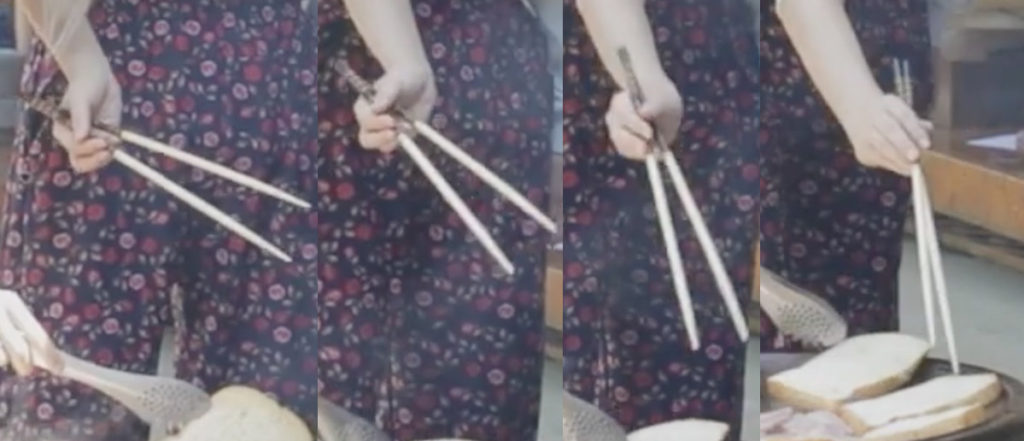
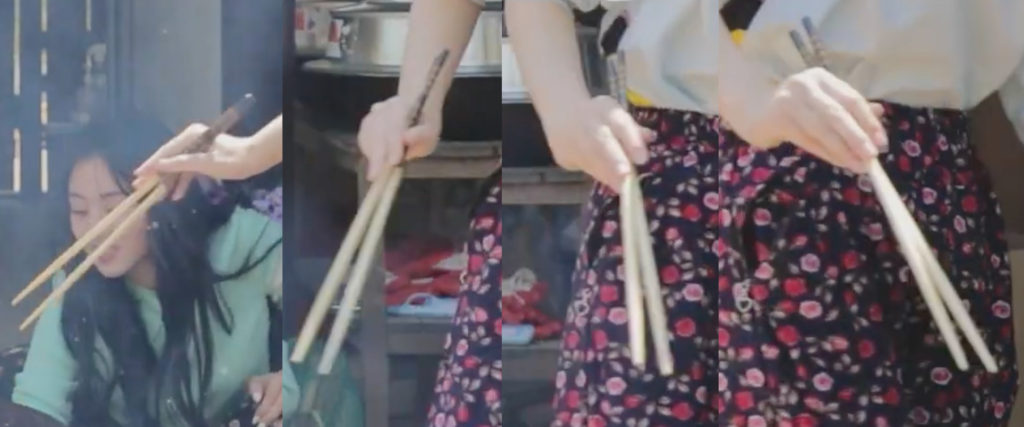


Following demonstrate the sideway swing we mentioned. Also unlike Cupped Vulcan is the the Momo holds two chopsticks abutting each other at the closed posture. This is similar to Italian Grip and Hook n Clamp. Cupped Vulcan, on the hand, always keep both chopsticks apart.
We almost called Momo’s grip “Cupped Vulcan.5”, where the “.5” refers to the modified finger support for the bottom chopstick. We have started to name grips with the “.5” suffix in our Classification of Chopstick Grips, where a variant changes the bottom chopstick support from the ring knuckle to pinky knuckle plus half a support from the side by the ring finger. This “.5” support can be seen in pictures shown below. But of course, by now we know this is not a simple “.5” variant of Cupped Vulcan.



Sometimes Momo switches from this unnamed grip to Forsaken Pinky, when she needs to extend tips of chopsticks very far apart, as illustrated below. The most visible change is the placement of the ring finger. It leaves the bottom chopstick to prop open the top chopstick.
Following pictures show Momo using plain chopsticks, instead of long cooking chopsticks. Here she appears to be wielding the Forsaken Pinky grip again. But she is not. Note how they is not using the thumb pad as Forsaken Pinky calls for. Again, rear ends of her chopsticks stay together all times, just like Italian Grip, Hook n Clamp, and Double Hook. In fact, this particular view of her grip may almost be called “Triple Hook”.
Nayeon: Scissorhand
Nayeon’s chopstick grip is different from all other grips we have discussed so far. This much is obvious, even to someone who has not yet read about dozens of chopstick grips we’ve analyzed. Chopsticks in her hand look undeniably crossed. Earlier we discussed Jihyo’s Italian Grip. That is also a grip with chopsticks that look crossed at the open posture. But Italian Grip barely extends two chopsticks apart. In comparison, Nayeon’s Scissorhand can easily extend chopsticks 45° apart to encompass large food items, as shown below.
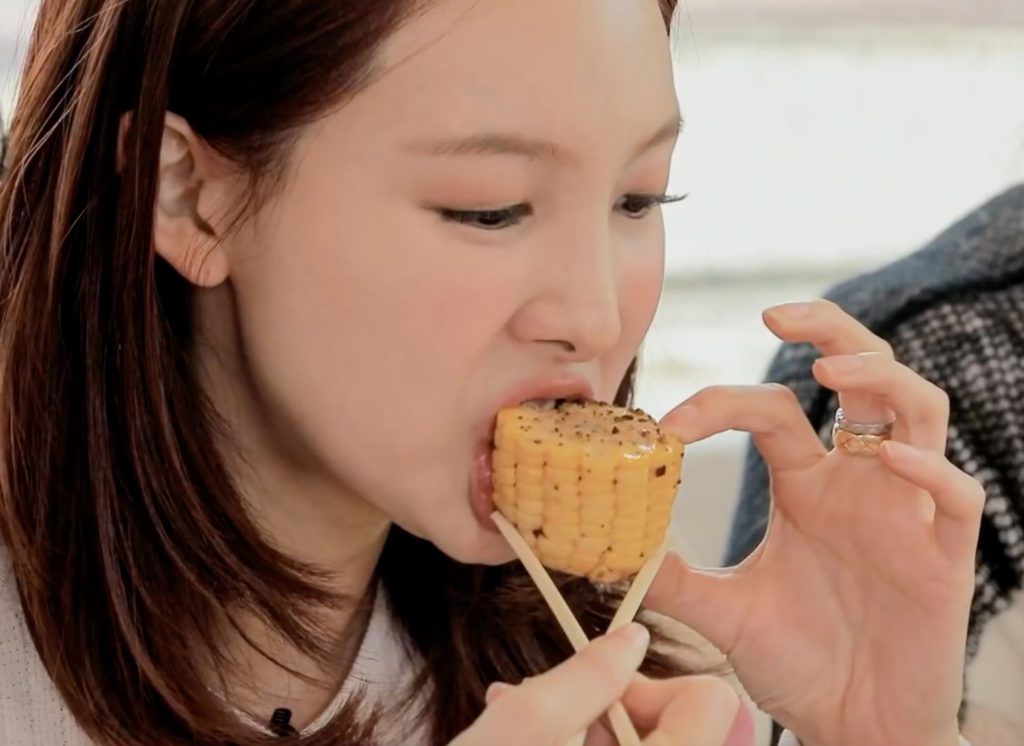
Scissorhand is an underswing variant of Chicken Claws. It shares the same abutting posture as Chicken Claws, where two chopsticks are clutched together with almost no separation.
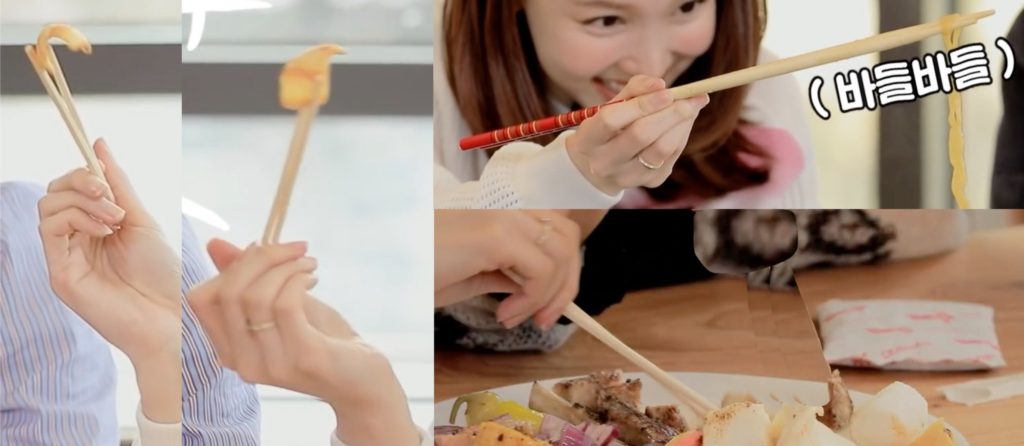
The relaxed open posture is observed from various perspectives, shown below.
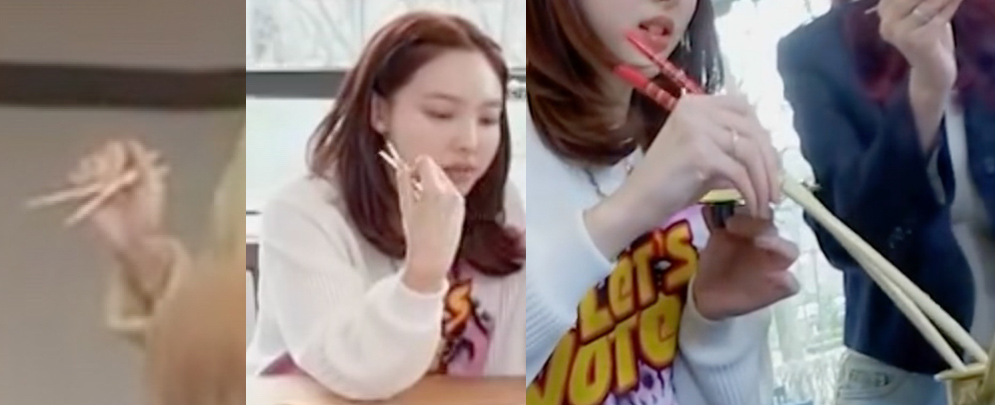
Here we have Nayeon pinching and picking up food with this underswing grip. Note how the index finger squashes the top chopstick against the bottom chopstick which is held up by the knuckle of the middle finger.

In addition to the index finger and middle finger, the thumb is also instrumental in clutching chopsticks together.

In YesNo episode 3, Nayeon was given long cooking chopsticks, with tapered tips. Picking up noodles using a grip with Lateral compression is already hard. This is exacerbated when with these long and tapered chopsticks. Clutching chopsticks shut at the mid point leaves wide gaps at the tips of chopsticks in this case, as shown below. We have discussed this issue previously in the WorldFriend article, when describing Jane’s Double Hook grip with a Lateral compression.

Sana: Idling Thumb
Sana wields exclusively the Idling Thumb grip. Some other TWICE members uses Idling Thumb as well, but they don’t exclusively use Idling Thumb. Jeongyeon, for instance, wields a grip halfway between Standard Grip and Idling Thumb. Dahyun also uses Idling Thumb, but she switches back and forth between Idling Thumb, Chicken Claws and Double Hook.
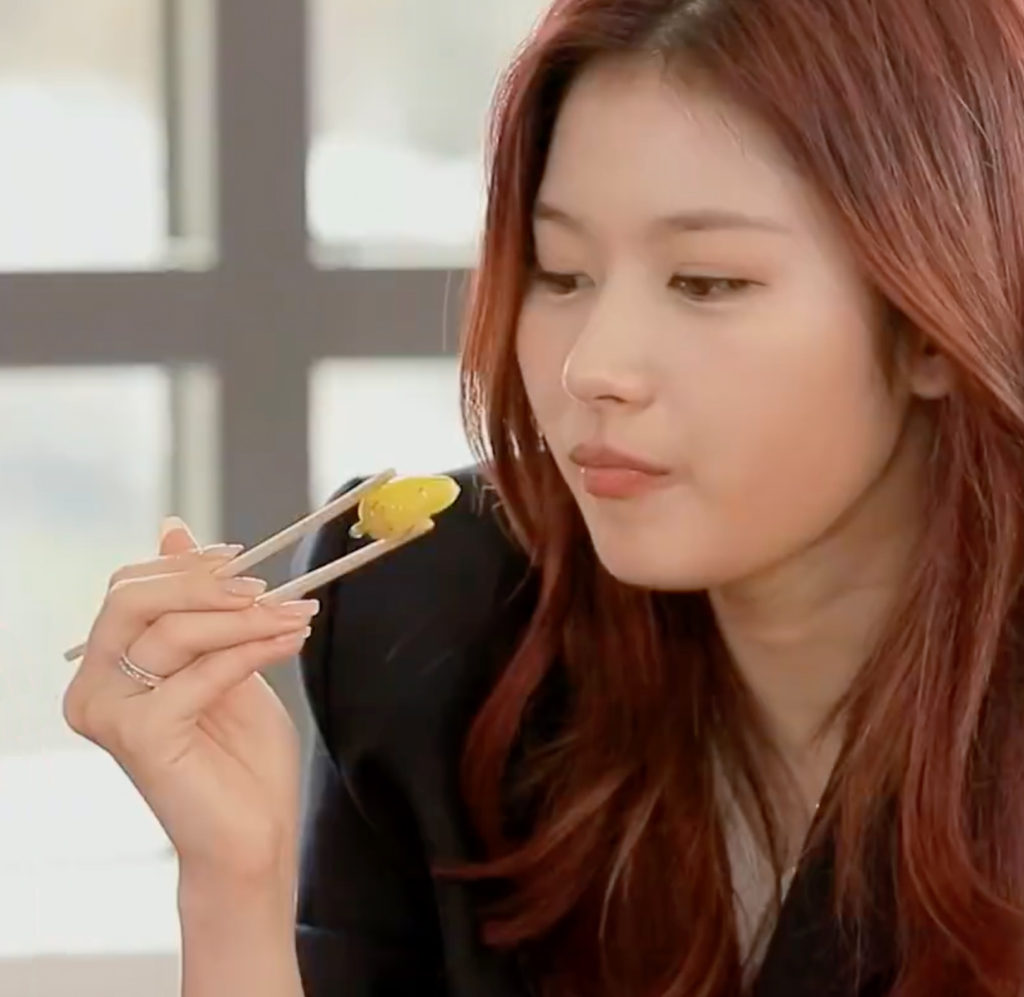
Sana always keeps the rear ends of chopsticks apart, true to Idling Thumb. She never uses the thumb pad to operate the top chopstick, another hallmark of Idling Thumb.

Following are views of the relaxed, open posture as seen from different perspectives.

When chopsticks need to be extended further apart, the index finger and the middle finger sandwich the top chopstick, and lift it away from the bottom chopstick.
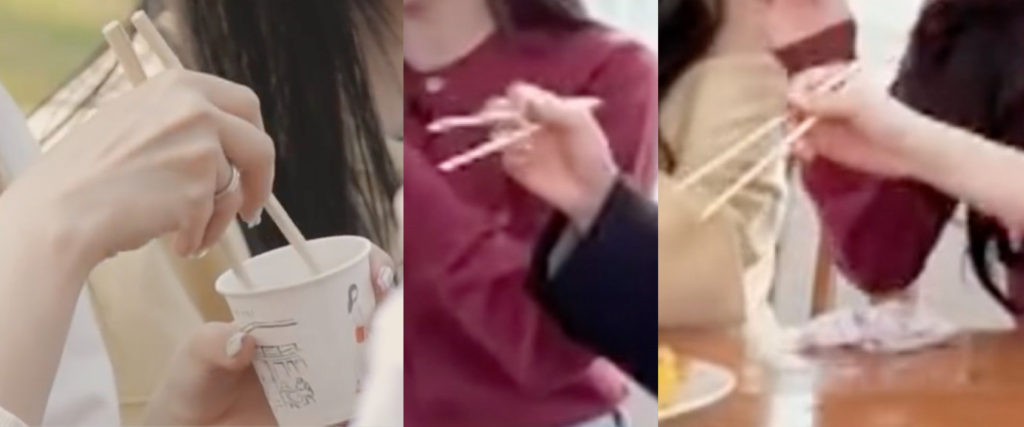
Following show the relaxed, closed posture. Earlier we wrote about Dahyun, and how her Idling Thumb grip temporarily turned into a Turncoat grip. The relaxed, closed posture of Idling Thumb almost indistinguishable from the posture in Turncoat, as shown below.
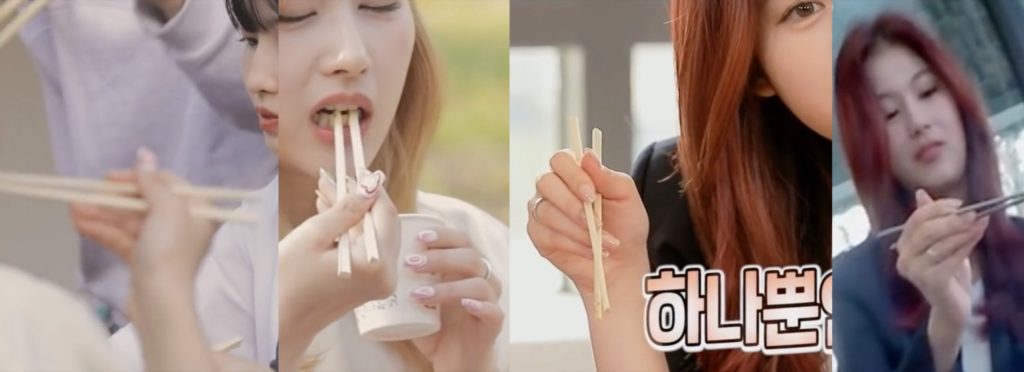
Compression postures shown below more clearly illustrate the transition from Idling Thumb to Turncoat. Note how the middle finger moves to the bottom chopstick quite often in this posture.

Tzuyu: Idling Thumb.5 and Double Hook.5
Tzuyu singlehandedly provided us with the first examples of two theoretical “.5” variants that we’ve been searching for. By “.5” variant we refer to a modified finger support for the bottom chopstick where both the ring finger and the pinky provide support, instead of a single ring finger support as used in Standard Grip. Since the discovery of Double Tripod, and Vulcan.5, we’ve been looking for more examples of “.5” variants. We have incorporated this factor into our Classification of Chopstick Grips. Tzuyu just helped us confirm this theory that many grips have a “.5” variant. We have found Idling Thumb.5 and Double Hook.5.
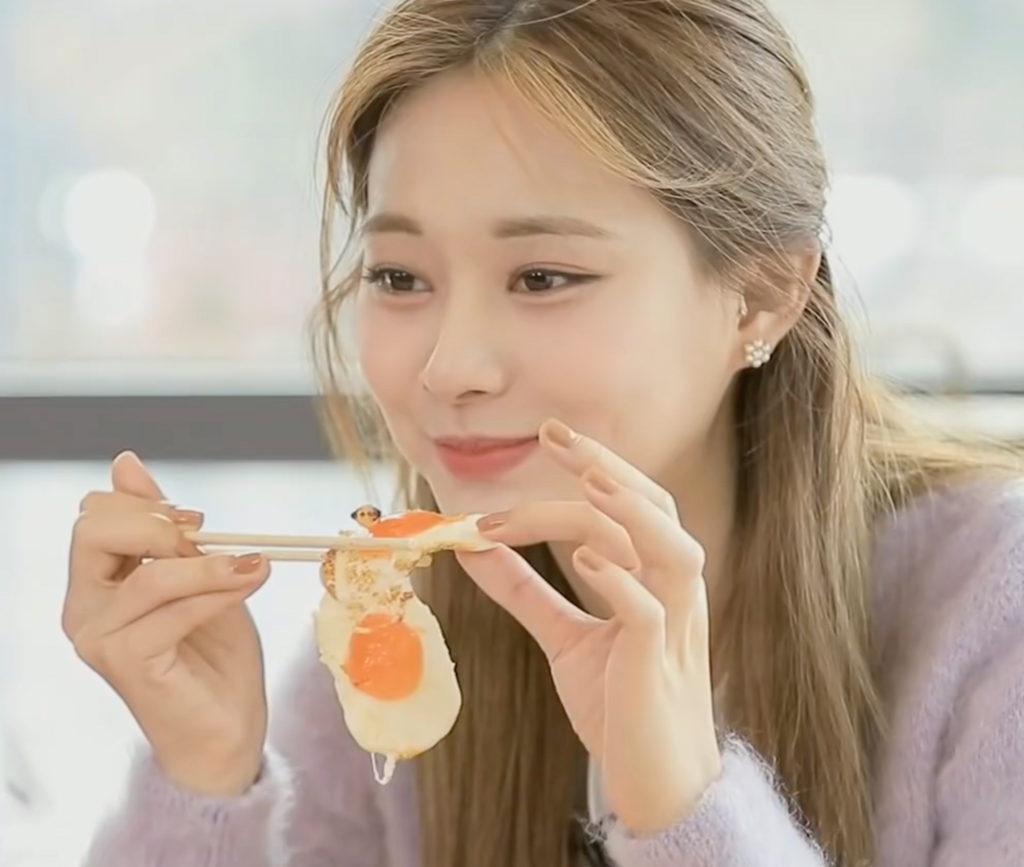
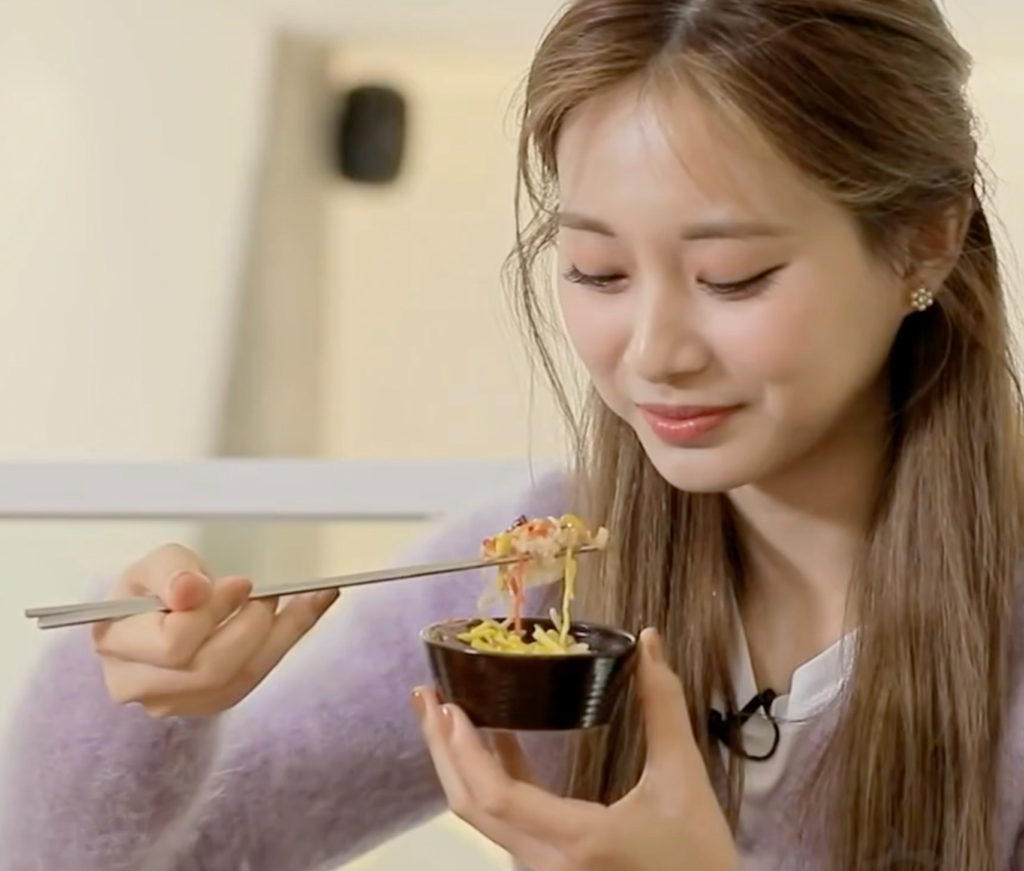
As we noted in the Double Hook article, Double Hook is a cross of Idling Thumb and Chicken Claws. All three are closely related. Earlier in this article, Dahyun provided the best proof of this concept – she wield all three related grips: Chicken Claws, Double Hook and Idling Thumb.
Tzuyu switches between Idling Thumb.5 and Double Hook.5 at will, for the same reason. These two “.5” grips are related to one another, just like Idling Thumb and Double Hook are. In addition, Tzuyu also transitions between Double Hook.5 and Double Hook as needed.
Following pictures demonstrate her Idling Thumb.5 grip. Note how rear ends of chopsticks are separated at the open posture (below left). Notice that her index finger and middle finger are curved at the open posture. Note how the index finger flattens to squash down the top chopstick at the compression posture (below right). And most importantly, note how the bottom stick is supported by both the ring finger pad and the pinky knuckle – the hallmark of a “.5” variant.

Following pictures illustrate how Tzuyu picks up food with Idling Thumb.5. The movement starts with the index finger and the middle finger lifting the top chopstick. Then the index finger squashes the top chopstick downward, to pinch food. Lastly, she turns her wrist to pick the food up.

Following pictures illustrate Tzuyu’s Double Hook.5 grip. These differ from the Idling Thumb.5 versions, in that at the open posture Double Hook.5 has rear ends of chopsticks squeezed together.

Following pictures show Tzuyu dropping food off with her Double Hook.5 grip, starting with the compression posture (leftmost), and ending at the open posture (rightmost).

Following pictures illustrate the abutting posture of Tzuyu’s Double Hook.5 grip, where food items are small enough such that the two chopstick abut each other at the compression posture.

Sometimes the middle finger temporarily relieves the index finger, taking over its duty in keep the two chopsticks shut against each other. We’ve seen this often with everyone’s grip. People are not robots.

Sometimes Tzuyu transitions from Double Hook.5 to Double Hook, shown below. These two grips differ only in how the bottom chopstick is supported. In the case of Double Hook, the ring finger knuckle alone provides the support.
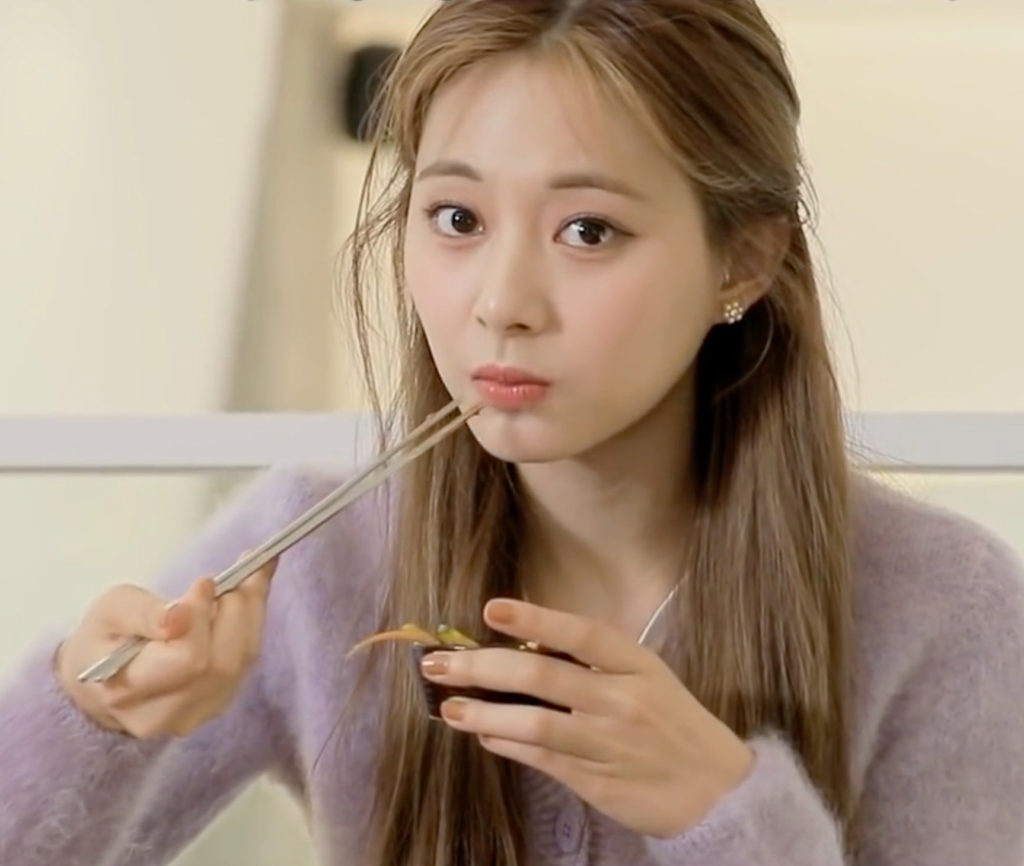


Summary
The following video presents chopstick team scores compiled from this article:

